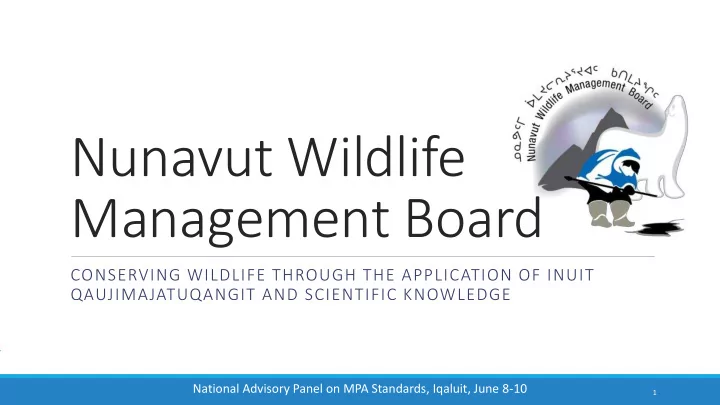

Nunavut Wildlife Management Board CONSERVING WILDLIFE THROUGH THE APPLICATION OF INUIT QAUJIMAJATUQANGIT AND SCIENTIFIC KNOWLEDGE National Advisory Panel on MPA Standards, Iqaluit, June 8-10 1
Overview o NWMB mandate o NWMB Responsibilities o Co-Management in Nunavut o Challenges for the use of IUCN guidelines in Nunavut o Addressing challenges in Nunavut National Advisory Panel on MPA Standards, Iqaluit, June 8-10 2
NWMB Mandate o NWMB is the main instrument of wildlife management and the main regulator of access to wildlife in the Nunavut Settlement Area (NSA) o Institution of public government and independent tribunal o Vision: Conserving wildlife and habitat through the application of Inuit Qaujimajatuqangit and scientific knowledge o Responsibilities assigned by Nunavut Agreement: • Article 5, Wildlife; • Article 8, Parks; • Article 9, Conservation Areas; • Article 15, Marine Areas 3
NWMB Responsibilities o Functions: • Approve boundaries of conservation areas • Advice to NPC regarding important wildlife areas • Approve management/protection plans for wildlife habitats including within Protected Areas • Participating in or facilitating wildlife research in Nunavut • Establishing/modifying/removing total allowable harvests and non-quota limitations Photo: M. Ghazal • Management/designation/protection of rare, threatened and endangered wildlife 4
Co-Management in Nunavut o Co-management partners: organizations with wildlife management responsibilities • Government, Inuit organizations • Communities, Non-Governmental Organizations, and public o Making decisions and recommendations to Ministers Photo: F. Lemire o Cooperatively conserve wildlife and habitat for the long-term benefit of Nunavummiut o Respects Inuit harvesting rights and priorities o Uses best available information: Inuit Qaujimajatuqangit and science Photo: CBC 5
Considerations for MPAs in Nunavut o Are there specific circumstances unique to Canada that pose challenges for the use of the IUCN guidelines? o How should these circumstances be addressed? o Co-management in Nunavut: 1. Nunavut Agreement 2. Engagement With Co-management Partners and Communities 3. Timelines 4. Remoteness and Low Population Density 6
1. Nunavut Agreement o IUCN guidelines do not necessarily prescribe the use of traditional knowledge sources. o In Nunavut, there is a need for the use of both Inuit Qaujimajatuqangit and scientific knowledge in all aspects of wildlife management and protection of habitat ( Nunavut Agreement S. 5.1.2 [e, h]). 7
1. Nunavut Agreement o Using traditional knowledge represents knowledge accumulated through many generations through close interactions between people and the environment. o Ensure that Inuit Qaujimajatuqangit is meaningfully incorporated into each step of the MPA planning, establishment, and operation. 8
2. Engagement o Organizations need to engage with co-management partners, stakeholders, and communities that will be affected by the establishment of a Marine Protected Area o Consensus can be difficult to reach with varying mandates and perspectives of stakeholders 9
2. Engagement o Engagement and consensus by co-managers, stakeholders, and communities ensures that factors affecting the success of a MPA such as proper regulations, enforcement, and location of a MPA are considered o Potential solution: ensuring that all co-management partners and communities are engaged with from the beginning of the process and onward o Potential solution: engaging stakeholders to determine how their ideas can complement one another 10
3. Timelines o Canada is committed to protecting 10 percent of coastal and marine areas by 2020 o Often the success or failure of an MPA is determined by the processes that lead to their establishment – ‘step zero’ o The goal of ‘quickly’ establishing MPAs could conflict with the ability to adequately consult and accommodate o NWMB may not be able to execute its decision-making process if timeline is too short o Pursuant to s. 5.2.34(a) of the Nunavut Agreement , NWMB approve the establishment, disestablishment, and changes to boundaries of Conservation Areas, related to management and protection of wildlife and wildlife habitat; 11
3. Timelines o Potential solution: Engagement needs to be scheduled well in advance and provide stakeholders with the opportunity to meet and issue formal responses o Potential solution: Update relevant parties, including HTOs and RWOs regularly and seek feedback about potential issue o NWMB holds quarterly meetings in March, June, September, and December – organizations can provide update on progress 12
4. Remoteness and Low Population Density o Nunavut Settlement Area covers approximately 2,000,000 km 2 with a population of 38,000. o Regulations may involve impeding commercial activities or shipping from outside Canada or Nunavut. o Difficult to enforce MPA regulations in Nunavut because of cost, remoteness, and few people in certain areas. 13
4. Remoteness and Low Population Density o “… most MPAs depend on the support of local communities for survival and such support may well depend on recognition of the contribution which the MPA makes to human welfare through maintaining biological productivity.” (IUCN Guidelines for MPAs) o Potential solution: Local buy-in from community stakeholders will be important to ensure the success of an MPA in Nunavut. 14
Photo: M. Ghazal QUESTIONS? NWMB.com 15
Recommend
More recommend